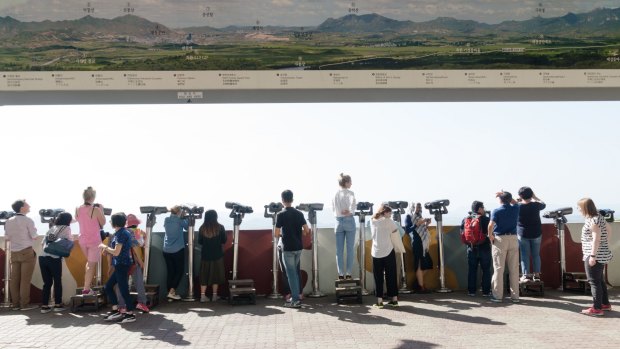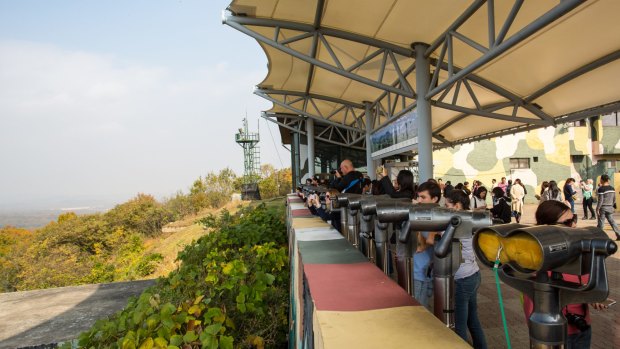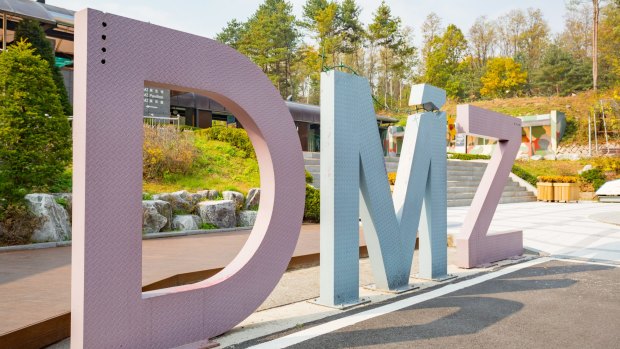This was published 4 years ago
Why you should visit the world's only Demilitarised Zone in South Korea now
By Libby Moffet

Tourists look through binoculars at Dora Observatory, DMZ.Credit: iStock
It's the middle of the day but the vast hall of South Korea's Dorasan railway station is almost empty when we enter, save for a handful of tourists examining a display of photographs and sculptures.
A note from artist Cho Joon Hui captures the despair and hope that sit side by side in this unusual exhibition: "If Korea can't connect to the rest of Asia through this railway, then the Korean Peninsula may as well be an island."
Welcoming only the occasional tourist train from Seoul, Dorasan may be South Korea's loneliest railway station. But it's arguably the most important, given it is less than a kilometre from the Demilitarised Zone (DMZ) dividing South and North Korea.

Tourists look into Noprth Korea from Dorasan lookout on the border.
With the two countries slowly edging closer to officially ending the civil war that led to the creation of the DMZ more than 65 years ago, this gleaming glass and chrome terminal is waiting to take on the reunification role for which it was built in 2002.
South Koreans hope Dorasan will not only play a key role in reconnecting them with family and friends in the north, but that it will also be a vital part of a strategic rail network linking a reunited Korea to China, Russia and Europe via the existing Trans-Siberian and Trans-Manchurian railways. The envisaged Trans-Korean rail network would provide an important cargo route for the two nations as well as a passenger experience like no other, creating the world's longest train journey from Seoul to Moscow.
The south's rail aspirations are shared by the north, with representatives from the Republic of Korea (ROK) joining northern counterparts from the Democratic People's Republic of Korea (DPRK) for a ceremonial linking of their tracks, north of the DMZ, late last year. But plans to upgrade the north's ageing rail system and advance the network remain stalled while North Korea and the United States continue their diplomatic dance on economic sanctions and denuclearisation of the peninsula, the latest moves happening in June when US President Donald Trump took 20 steps over the DMZ border onto North Korean territory, with North Korean leader Kim Jong-un alongside.

The Third Tunnel Statue, site of the Third Infiltration Tunnel, in the DMZ.Credit: iStock
While the hurdles are significant, South Korea's excitement at the prospect of becoming part of a Trans-Eurasian railway network is evident at Dorasan. Here not one but two huge rail network maps convey the potential of what lies ahead, while a nearby platform sign indicates the departure point for the much-anticipated train to North Korea's capital, Pyongyang, 205 kilometres to the north. An adjoining customs hall and rows of passenger seats await a moment that South Korea hopes will come soon.
But for now, only the station's southbound track is in operation, carrying a small government-run tourist train on a 56-kilometre shuttle run between Seoul and Dorasan, six days a week.
Most visitors to the station arrive by coach on tours that take in the key sites of the DMZ and the adjoining Civilian Controlled Zone, where Dorasan is located. Many are keen to visit the Joint Security Area (JSA), where North and South Korean soldiers eyeball each other at the border line.
However, while it is regarded as the highlight of any DMZ tour, access to the JSA cannot be guaranteed. In late 2017, escalating tensions between the north and south kept the area closed for long periods.
Ironically, it is the increased prospect of peace that keeps the JSA off limits to us. Our guide, Bo Geun, says the area was open to visitors for only four days in the month that we visit South Korea, due to a recent agreement between the two nations to start removing thousands of landmines in the border area.
But there is still plenty to see on our half-day tour, which takes us on a fascinating trail between four key DMZ locations – the Bridge of Freedom, the third infiltration tunnel, Dora Observatory and Dorasan station. Security is intense, and the surrounding armed troops, tank traps and barbed wire, along with Bo Geun's constant exhortations to our group to obey the rules at each stop, adds to the tension.
Indeed, everyone's heart is pounding by the time we have quickly hiked several hundred metres inside the North Korean-built infiltration tunnel which lies more than 70 metres under the DMZ surface, our helmets often banging on the low roof as we stoop to make our way along the passage discovered by South Korea in 1978.
At the Bridge of Freedom, where prisoners of war were returned to the south in 1953, silence falls as we study the thousands of colourful ribbons that cover the wire fencing, each bearing messages of love and hope from South Koreans to the friends and families they are separated from in the north.
At Dora Observatory, we peer across the DMZ into North Korea through binoculars, searching for signs of life around Kijong-dong, or Peace Village, built by North Korea to symbolise its way of life, but referred to as Propaganda Village by South Koreans, who say it is uninhabited.
All four areas we visit tell the story of the world's only demilitarised zone, but it becomes clear as the morning progresses that while the first three sites are legacies of the conflict between the south and north, Dorasan station alone is part of the solution.
Bo Geun tells us she has been to the DMZ more than 1000 times in her 14 years as a guide, which perhaps explains why our tour is so exceptional. Throughout the morning she reels off facts and figures about the two nations and gives us personal insights into the conflict. She recalls the days when propaganda radio stations from both sides used to blast their messages so loudly her groups could barely hear her speak, as well as the dark times of 2008 after North Korean soldiers shot dead a South Korean tourist in the DMZ. During tense times in 2017, when Kim Jong-un was flexing his missile muscle, DMZ visitor numbers fell markedly and only a small number of coaches made the trip each day.
Now, with hopes of a peace agreement between the countries, business is booming. It's clear that not only do DMZ visitors feel "safe" in the current climate, there is increasing awareness that the zone's days may finally be numbered. The South Korean government's move to introduce hiking tours through the DMZ in April this year is another step along the path to turn the fortified area into a peace zone.
Standing within Dorasan station, the hope seems palpable. The sculpture exhibition is positioned alongside a display of large framed images of Kim Jong-un meeting South Korea President Moon Jae-in for historic peace talks at the border last year.
The tourist train arrives during our visit, its passengers spilling into the terminal under the watchful eye of South Korean soldiers. We join the visitors as they mark pieces of paper with the station's official rubber stamps and linger at the railway network maps.
Bo Geun's words ring in my ears: "Seoul to Paris by train – can you just imagine being on that journey!"
But for now it's our coach south to Seoul that awaits, so we hurriedly finalise our purchases at the station's small kiosk where a collection of stamps from the DPRK has caught my eye.
Six thousand won (about $7.50) for eight stamps seems a small price to pay for a piece of history. They say postage stamps as we know them may well disappear in my lifetime – and now it seems the same may be said for the DPRK.
TRIP NOTES
Libby Moffet travelled at her own expense.
MORE
VISIT
South Korea's DMZ can only be visited as part of an organised tour, which can be booked through a number of Korean tour companies. VIP Travel offers a range of DMZ tours including a half-day tour to Dorasan Station, Freedom Bride, Dora Observatory and the 3rd Infiltration Tunnel. The tour is available every day except Mondays and national holidays, and costs about $70 a person. See vviptravel.com
STAY
The Grand Hyatt Seoul is well located on the edge of Namsan Park with views over the city. Rooms from $220 a night. See hyatt.com
FLY
Korean Air flies from Sydney to Seoul daily. See koreanair.com
Sign up for the Traveller Deals newsletter
Get exclusive travel deals delivered straight to your inbox. Sign up now.